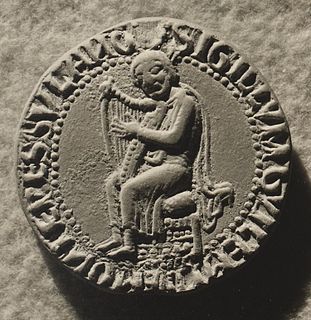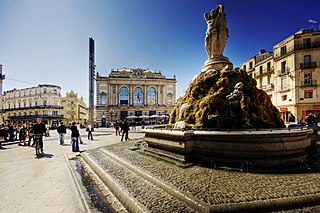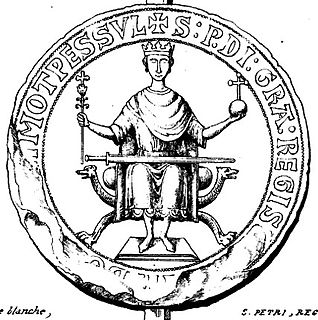
Peter II the Catholic was the King of Aragon and Count of Barcelona from 1196 to 1213.
William VI or Guillem VI was the eldest son of William V and his wife Ermessende, daughter of Count Peter II of Melgueil. William succeeded his father in the lordship of Montpellier in 1121, while still a minor, under his mother's guardianship. He suppressed a revolt of the bourgeoisie in 1143 and participated in several military campaigns of the Reconquista in Spain. He also increased the public character of the lordship in Montpellier and supported the growth of its trade.
William V was the Lord of Montpellier from 1068 until his death. He was the son of William IV.

Peire d'Alvernhe or d'Alvernha was an Auvergnat troubadour with twenty-one or twenty-four surviving works. He composed in an "esoteric" and "formally complex" style known as the trobar clus. He stands out as the earliest troubadour mentioned by name in Dante's Divine Comedy.
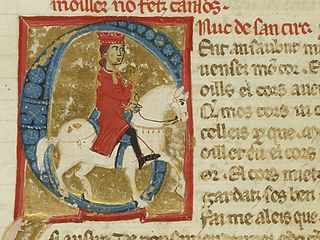
Uc de Saint Circ or Hugues (Hugh) de Saint Circq was a troubadour from Quercy. Uc is perhaps most significant to modern historians as the probable author of several vidas and razos of other troubadours, though only one of Bernart de Ventadorn exists under his name. Forty-four of his songs, including fifteen cansos and only three canso melodies, have survived, along with a didactic manual entitled Ensenhamen d'onor. According to William E. Burgwinkle, as "poet, biographer, literary historian, and mythographer, Uc must be accorded his rightful place as the 'inventor' (trobador) of 'troubadour poetry' and the idealogical trappings with which it came to be associated."

Gui de Cavalhon, Cavaillo, or Gavaillo was a Provençal nobleman: a diplomat, warrior, and man of letters. He was probably also the Guionet who composed tensos and partimens with Cadenet, Raimbaut de Vaqueiras, Mainart Ros, Pomairol, and a certain Guillem.
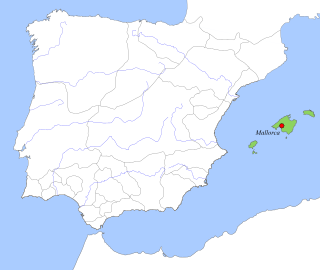
In 1114, an expedition to the Balearic Islands, then a Muslim taifa, was launched in the form of a Crusade. Founded on a treaty of 1113 between the Republic of Pisa and Ramon Berenguer III, Count of Barcelona, the expedition had the support of Pope Paschal II and the participation of many lords of Catalonia and Occitania, as well as contingents from northern and central Italy, Sardinia, and Corsica. The Crusaders were perhaps inspired by the Norwegian king Sigurd I's attack on Formentera in 1108 or 1109 during the Norwegian Crusade. The expedition ended in 1115 in the conquest of the Balearics, but only until the next year. The main source for the event is the Pisan Liber maiolichinus, completed by 1125.

The Liber feudorum maior, originally called the Liber domini regis, is a late twelfth-century illuminated cartulary of the Crown of Aragon. It was compiled by the royal archivist Ramon de Caldes with the help of Guillem de Bassa for Alfonso II, beginning in 1192. It contained 902 documents dating as far back as the tenth century. It is profusely illustrated in a Romanesque style, a rarity for utilitarian documents. The LFM is an indispensable source for the institutional history of the emerging Principality of Catalonia. It is preserved as a file in the Arxiu de la Corona d'Aragó (ACA), Cancelleria reial, Registres no. 1, in Barcelona.
The Liber instrumentorum vicecomitalium, sometimes called the Trencavel Cartulary (CT) or Cartulaire de Foix, is a high medieval cartulary commissioned by the Trencavel family. It preserves either 585 or 616–7 charters, the earliest of which dates to 1028 and the latest to 1214. The charters preserve a record of important feudal customs relating to the lands of the Trencavel, namely Albi, Agde, Béziers, Carcassonne, Nîmes, and Razès, all of which—save Carcassonne, which was a county—were viscounties, hence the cartulary's name. It is preserved in a twelfth-century manuscript, now kept with the Société Archéologique de Montpellier, where it is MS 10.
The Chronique romane or Chronicle of Montpellier is an Old Occitan and Middle French chronicle of the city of Montpellier. The Chronique was probably made for the use of town officials, who would have wanted a record of local history for help in administration and in forging civic pride. The recording of town officials, such as council members, was also important, and in two manuscripts the Chronique is found along with the Charte de 1204, a compilation of local customary law. Its annalistic format was typical of civic chronicles of the same period.
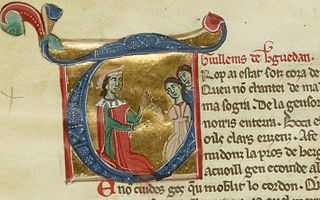
Guillem de Berguedà, or Guilhem de Berguedan in Occitan, was a Catalan troubadour and viscount of Berguedà. He was the most prolific Catalan poet of the twelfth century, though he composed in Occitan, and thirty-one of his poems survive. Most are sirventes, "typically violent and obscene, reflecting his character and turbulent life," but there are a few cansos. Most of what is known about him derives from his vida and his songs.

Gomelo II was the Bishop of Oviedo during the final years of the reign of Alfonso III of Asturias. He succeeded Hermenegild I probably about 892. Only one document from his episcopate survives, though it was interfered with at a later date by Pelagius of Oviedo. Dated 20 January 905, it is charter of the Cathedral of San Salvador signed by a bishop Gomellus along with the bishops Froilán of León, Sisenand of Iria, Nausto of Coimbra, and Reccared of Lugo. The charter ordered the construction of a castle beside the church in order to house relics—and refugees—during Viking attacks. The cathedral also received as gifts books, ornaments, villages, monasteries, churches, and rents of all kinds, but the jurisdiction over the church of Santa María de Lugo and the towns of Avilés and Gijón also given appear to be later (forged) additions. A 1612 copy of this diploma was mis-dated 1 February 925, but the list of bishops confirms the date of the copy in the cartulary of Oviedo.
Aeci, Bishop of Barcelona from 995, was a warrior-prelate in the age of the Peace and Truce of God. Besides military endeavours, mainly reconquista, his episcopate was taken up with the repoblación (re-settlement) of the Penedès in the south of the diocese, on the frontier with al-Andalus.
Sal·la was the Bishop of Urgell from 981 to 1010, and "one of the first Catalan figures whose own words" survive sufficiently "to give colour to his personality and actions", although all of the words attributed to him were written down by scribes. He receives mention in some sixty-three surviving contemporary documents. As bishop, Sal·la dated documents by the reign of Hugh the Great. Although his episcopate largely preceded the Peace of God movement in Catalonia, his excommunication of high-ranking public figures during a church–state dispute in 991 anticipated it. He also pioneered feudal practices such as the granting of fiefs and was frequently "ahead of the feudalising wave".
William III was the Lord of Montpellier from 1025 until his death in 1058. He was the son of William II and husband of Beliardis. His son and successor was William IV. He is the last of the "shadowy" lords of Montpellier, none of whose charters are conserved in the family cartulary, the Liber instrumentorum memorialium.
William IV was the Lord of Montpellier from 1058 until his death in 1068. He was the son of William III and Beliardis. He was married to Ermengarde, daughter of Raymond I, Count of Melgueil. He is the first of his dynasty with charters preserved in the family cartulary, the Liber instrumentorum memorialium. They record agreements concerning some local castles in 1059. He was succeeded by his son, William V.
William IX was the lord of Montpellier from 1202 until 1204. He was the last lord of the Guilhem lineage.



